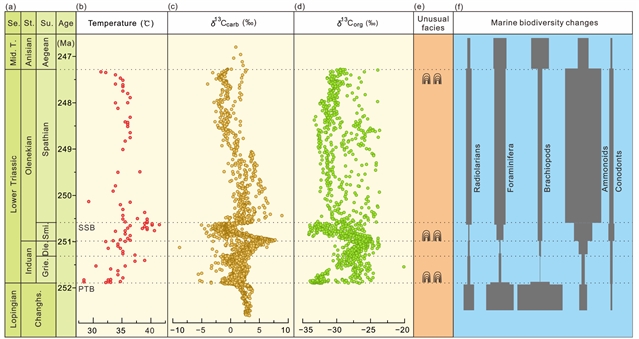
近日,北京大学沈佳恒团队揭示了长时间的硝酸盐消耗延缓了二叠纪末大灭绝后海洋生态系统的恢复。2025年7月28日出版的《中国科学:地球科学》杂志发表了这项最新研究成果。
在显生宙最严重的大灭绝事件之后,早三叠纪标志着生态系统在持续环境压力下恢复的关键阶段。虽然以前的研究已经检查了这段时间内的氮循环,以了解生物恢复和环境动态,但海洋硝酸盐水平的定量重建仍然有限。
研究组收集了早三叠世全球δ15N数据,采用稳态盒模型重建了海洋硝酸盐有效性的时间变化。结果表明,中国南方同化物-硝酸盐储层(同化物)中氮的埋藏分数经历了3个不同的演化阶段:从二叠纪-三叠纪界线(PTB)到史密斯-斯帕塔界线(SSB)一直处于低位(~0.06),在SSB之后增加到~0.2,在斯帕塔晚期下降到~0.09。这种演变主要是由温度驱动的海洋分层、上升流强度和氧化还原条件的变化控制的。
此外,华南和盘古大陆西北部之间的同化值差异很大。在SSB之前,这些区域差异可能反映了海洋硝酸盐库存的变化,而在SSB之后,它们可能受到气候变冷的空间变化响应的支配。早三叠纪海洋中硝酸盐的持续消耗有利于细菌主导的浮游植物群落。这种低生产力状态,加上铵对后生动物的毒性,可能推迟了二叠纪末大灭绝后海洋生态系统的恢复。
附:英文原文
Title: Prolonged nitrate depletion delayed marine ecosystem recovery after the end-Permian mass extinction
Author: Youren MA, Zhaoxia GE, Jiaheng SHEN
Issue&Volume: 2025/07/28
Abstract: Following the most severe mass extinction event of the Phanerozoic Eon, the Early Triassic marked a critical stage of ecosystem recovery under persistent environmental stress. While previous studies have examined the nitrogen cycle during this interval to understand biotic recovery and environmental dynamics, quantitative reconstructions of marine nitrate levels remain limited. In this study, we compiled global δ15N data from the Early Triassic and used a steady-state box model to reconstruct temporal variations in marine nitrate availability. The results reveal that the fraction of nitrogen buried from the assimilator-nitrate reservoir (fassimilator) in South China evolved through three distinct stages: remaining low (~0.06) from the Permian-Triassic boundary (PTB) to the Smithian-Spathian boundary (SSB), increasing to ~0.2 after the SSB, and declining to ~0.09 during the late Spathian. This evolution was primarily controlled by temperature-driven changes in ocean stratification, upwelling intensity, and redox conditions. Furthermore, fassimilator values differed substantially between South China and northwestern Pangea. Prior to the SSB, these regional differences likely reflected variations in marine nitrate inventories, whereas after the SSB, they may be governed by spatially variable responses to climatic cooling. The persistence of nitrate depletion in Early Triassic oceans favored bacteria-dominated phytoplankton communities. This low-productivity state, together with ammonium toxicity to metazoans, may have delayed marine ecosystem recovery after the end-Permian mass extinction.
DOI: 10.1007/s11430-025-1629-8
Source: https://www.sciengine.com/SCES/doi/10.1007/s11430-025-1629-8
Science China Earth Sciences:《中国科学:地球科学》,创刊于1952年。隶属于施普林格·自然出版集团,最新IF:5.7
官方网址:https://www.sciengine.com/SCES/home
投稿链接:https://mc03.manuscriptcentral.com/sces
